Test Stand for a Motor Vehicle Powered by Different Fuels
Abstract
1. Introduction
- Load setting with the possibility of its smooth adjustment;
- Powering the engine with different fuels;
- Modifying software that directly affects the control strategies of the injection process, transmission and traction control systems;
- Real-time reading, recording and analysis of control system operating parameters;
- Detailed recording and analysis of the combustion process occurring directly in the combustion chamber;
- Measurement of emitted toxic substances.
- The position should integrate all the functionality listed above.
2. Materials and Methods
- Intake air temperature;
- MAP (Mass Air Pressure) intake manifold pressure;
- AFR (Air to Fuel Ratio);
- Engine oil temperature;
- Speed of rotation;
- Exhaust gas temperature.
- Measurement of acceleration versus speed;
- Measurement of acceleration versus vehicle speed;
- Measurement at constant engine speed versus time;
- Programmable driving cycles;
- Manual speed control using a manually controlled load;
- Taking into account the force of rolling resistance and elevation.
- Record and export diagnostic data to CSV file;
- Read ECU identification data;
- Read error codes;
- Erase error codes;
- Read parameters during engine Live Data;
- View parameter graphs;
- Carry out actuator tests;
- Provide a detailed description of fault codes, parameters and actuators;
- Reset and function programming.
- Representation of raw data is in the form of 2D graphics or a hexadecimal/decimal snapshot. Automatic processor detection to distinguish between program and calibration data area;
- Automatically search for map areas and place them in the map list;
- Display maps in 3D/2D or as a table;
- Automatic search for ECU and software numbers;
- Choice of language;
- Ability to calculate checksums;
- Import and export of binary files;
3. Results
Modifying the Control Map
4. Discussion
5. Conclusions
Author Contributions
Funding
Acknowledgments
Conflicts of Interest
References
- Williams, A. Fundamentals of oil combustion. Prog. Energy Combust. Sci. 1976, 2, 167–179. [Google Scholar] [CrossRef]
- Strayer, R.C.; Blake, J.A.; Craig, W.K. Canola and high erucic rapeseed oil as substitutes for diesel fuel: Preliminary tests. J. Am. Oil Chem. Soc. 1983, 60, 1587–1592. [Google Scholar] [CrossRef]
- Babu, A.K.; Devaradjane, G. Vegetable oils as fuel for diesel engines: An overview. In Proceedings of the ASME International Mechanical Engineering Congress and Exposition, New Orleans, LA, USA, 17–22 November 2002; American Society of Mechanical Engineers (ASME): New York, NY, USA, 2002; Volume 3, pp. 313–318. [Google Scholar]
- Luise, L. Particulate Emission from Gasoline Direct Injection Engine. In Engine Exhaust Particulates; Springer: Berlin/Heidelberg, Germany, 2019; pp. 215–237. [Google Scholar]
- Vicentea, G.; Bautistaa, L.F.; Rodrígueza, R.; Gutiérreza, J.; Sádabaa, I.; Ruiz-Vázquezb, R.M.; Torres-Martínez, S.; Garre, V. Biodiesel production from biomass of an oleaginous fungus. Biochem. Eng. J. 2009, 48, 22–27. [Google Scholar] [CrossRef]
- Hamasaki, K.; Tanaka, Y.; Nakamura, T.; Takaki, T. Effects of Injection System on Performance of a Direct-Injection Diesel Engine with Emulsified Rapeseed Oil Fuels. Trans. Japan Soc. Mech. Eng. Ser. B 1995, 61, 339–343. [Google Scholar] [CrossRef][Green Version]
- Moser, F.; Schloegl, H.; Wiesbauer, H. Traktorbetrieb mit rapsmethylester. Erdöl Erdgas Kohle/EKEP 1991, 107, 221–227. [Google Scholar]
- Hemmerlein, N.; Korte, V.; Richter, H.; Schröder, G. Performance, exhaust emissions and durability of modern diesel engines running on Rapeseed Oil. SAE Trans. 1991, 100, 400–415. [Google Scholar]
- Elsbett, K.; Elsbett, L.; Elsbett, G.; Behrens, M. New development in D.I. diesel engine technology. In Proceedings of the Society of Automotive Engineers international congress and exposition, Detroit, MI, USA, 27 February–3 March 1989. SAE Technical Papers 890134. [Google Scholar]
- Ziejewski, M.; Kaufman, K.R.; Schwab, A.W.; Pryde, E.H. Diesel engine evaluation of a nonionic sunflower oil-aqueous ethanol microemulsion. J. Am. Oil Chem. Soc. 1984, 61, 1620–1626. [Google Scholar] [CrossRef]
- Gorski, K.; Smigins, R. Impact of ether/ethanol and biodiesel blends on combustion process of compression ignition engine. In Proceedings of the Engineering for Rural Development, Jelgava, Latvia, 26–27 May 2011. [Google Scholar]
- Vallinayagam, R.; Vedharaj, S.; Yang, W.M.; Lee, P.S.; Chua, K.J.E.; Chou, S.K. Combustion performance and emission characteristics study of pine oil in a diesel engine. Energy 2013, 57, 344–351. [Google Scholar] [CrossRef]
- Lapuerta, M.; Herreros, J.M.; Lyons, L.L.; García-Contreras, R.; Briceño, Y. Effect of the alcohol type used in the production of waste cooking oil biodiesel on diesel performance and emissions. Fuel 2008, 87, 3161–3169. [Google Scholar] [CrossRef]
- Longwic, R.; Sander, P.; Zdziennicka, A.; Szymczyk, K.; Jańczuk, B. Combustion process of canola oil and n-hexane mixtures in dynamic diesel engine operating conditions. Appl. Sci. 2020, 10, 80. [Google Scholar] [CrossRef]
- Bortel, I.; Vávra, J.; Takáts, M. Effect of HVO fuel mixtures on emissions and performance of a passenger car size diesel engine. Renew. Energy 2019, 140, 680–691. [Google Scholar] [CrossRef]
- Fuć, P.; Merkisz, J.; Lijewski, P.; Bajerlein, M.; Ziółkowski, A.; Rymaniak, Ł.D. Badania emisji spalin w teście NEDC wykonane na dynamicznym silnikowym stanowisku hamulcowym. Combust. Engines 2013, 52, 701–707. [Google Scholar]
- Hetmańczyk, I.; Hepner, W.; Halicki, R. Modyfikacja charakterystyki zewnętrznej silnika o zapłonie samoczynnym poprzez zmianę parametrów wtrysku paliwa. Inżynieria Rol. 2013, 17, 79–89. [Google Scholar]
- Longwic, R.; Sen, A.K.; Górski, K.; Lotko, W.; Litak, G. Cycle-to-cycle variation of the combustion process in a diesel engine powered by different fuels. J. Vibroeng. 2011, 13, 120–127. [Google Scholar]
- Rakopoulos, C.D.; Giakoumis, E.G. Diesel Engine Transient Operation: Principles of Operation and Simulation Analysis; Springer: Berlin/Heidelberg, Germany, 2009. [Google Scholar]
- Rakopoulos, C.D.; Giakoumis, E.G. Review of thermodynamic diesel engine simulations under transient operating conditions. SAE Trans. 2006, 115, 467–504. [Google Scholar]
- Bazari, Z. Diesel exhaust emissions prediction under transient operating conditions. SAE Trans. 1994, 100, 1004–1019. [Google Scholar]
- Rajak, U.; Nashine, P.; Verma, T.N. Effect of spirulina microalgae biodiesel enriched with diesel fuel on performance and emission characteristics of CI engine. Fuel 2020, 268, 117305. [Google Scholar] [CrossRef]
- Nag, S.; Sharma, P.; Gupta, A.; Dhar, A. Experimental study of engine performance and emissions for hydrogen diesel dual fuel engine with exhaust gas recirculation. Int. J. Hydrog. Energy 2019, 44, 12163–12175. [Google Scholar] [CrossRef]
- Dey, S.; Reang, N.M.; Majumder, A.; Deb, M.; Das, P.K. A hybrid ANN-Fuzzy approach for optimization of engine operating parameters of a CI engine fueled with diesel-palm biodiesel-ethanol blend. Energy 2020, 202, 117813. [Google Scholar] [CrossRef]
- Hassan, A.A.; Elwardany, A.E.; Ookawara, S.; Ahmed, M.; El-Sharkawy, I.I. Integrated adsorption-based multigeneration systems: A critical review and future trends. Int. J. Refrig. 2020, 116, 129–145. [Google Scholar] [CrossRef]
- Das, B.; Pai, A.; Kini, C.R. Oxy-hydrogen hybrid diesel engine. ARPN J. Eng. Appl. Sci. 2020, 15, 1063–1068. [Google Scholar]
- Ibrahim, H.; Younès, R.; Basbous, T.; Ilinca, A.; Dimitrova, M. Optimization of diesel engine performances for a hybrid wind-diesel system with compressed air energy storage. Energy 2011, 36, 3079–3091. [Google Scholar] [CrossRef]
- Zhang, S.; Wu, Y.; Hu, J.; Huang, R.; Zhou, Y.; Bao, X.; Fu, L.; Hao, J. Can Euro V heavy-duty diesel engines, diesel hybrid and alternative fuel technologies mitigate NOX emissions? New evidence from on-road tests of buses in China. Appl. Energy 2014, 132, 118–126. [Google Scholar] [CrossRef]
- Valverde, V.; Mora, B.A.; Clairotte, M.; Pavlovic, J.; Suarez-Bertoa, R.; Giechaskiel, B.; Astor, C.; Fontaras, G. Emission factors derived from 13 Euro 6b light-duty vehicles based on laboratory and on-road measurements. Atmosphere 2019, 10, 243. [Google Scholar] [CrossRef]
- Longwic, R.; Sander, P. The course of combustion process under real conditions of work of a traction diesel engine supplied by mixtures of canola oil containing n-hexane. In Proceedings of the IOP Conference Series: Materials Science and Engineering, Nanjing, China, 17–19 August 2018; Volume 421. [Google Scholar]
- European Automobile Manufacture Association; Polski Związek Przemysłu Motoryzacyjnego. W Kierunku Zeroemisyjnej Mobilności. In Czynniki Determinujące Rozwój Napędów Alternatywnych w Samochdoach Osobowych i Dostawczych w Uni Europejskiej; ACEA: Brussels, Belgium, 2020. [Google Scholar]
- Lotko, W.; Longwic, R.; Swat, M. The Effect of Rape Oil—Diesel Oil Mixture Composition on Particulate Matter Emission Level in Diesel Engine; SAE Technical Paper 2001-01-3388; SAE International: Warrendale, PA, USA, 2001. [Google Scholar] [CrossRef]
- Górski, K.; Smigins, R.; Longwic, R. Research on physico-chemical properties of diethyl ether/linseed oil blends for the use as fuel in diesel engines. Energie 2020, 13, 6564. [Google Scholar] [CrossRef]
- Longwic, R.; Nieoczym, A.; Kordos, P. Evaluation of the combustion process in a spark-ignition engine based on the unrepeatability of the maximum pressure. In IOP Conference Series: Materials Science and Engineering; IOP Publishing: Bristol, UK, 2018. [Google Scholar]
- Sonachalam, M.; Manieniyan, V. Optimization of critical angle, distance and flow rate of secondary fuel injection in DI diesel engine using computational fluid dynamics. SN Appl. Sci. 2021, 3, 126. [Google Scholar] [CrossRef]
- Sonachalam, M.; Manieniyan, V. Comparative experimental analysis on dual fuel with biodiesel-acetylene in reactivity controlled compression ignition engine. Int. J. Ambient. Energy 2022. [Google Scholar] [CrossRef]
- Manieniyan, V.; Sukumar, V.; Senthilkumar, R.; Sivaprakasam, S. Emission reduction using biodiesel blends with nano-additives and reformed exhaust gas recirculation (REGR) in DI diesel engine. Int. J. Ambient. Energy 2019, 43, 641–647. [Google Scholar] [CrossRef]
- Manieniyan, V.; Senthilkumar, R.; Sukumar, V. Study on diesel engine characteristics using multi-walled carbon nanotubes blended thermal cracked vegetable oil refining waste, Materials today. Proceedings 2021, 37, 3665–3672. [Google Scholar]
- Sonachalam, M.; Paul Pandian, P.; Manieniyan, V. Emission reduction in diesel engine with acetylene gas and biodiesel using inlet manifold injection. Clean Technol. Environ. Policy 2020, 22, 2177–2191. [Google Scholar] [CrossRef]
- Sander, P.; Longwic, R.; Zdziennicka, A.; Jańczuk, B.; Szymczak, K. The Use of Canola Oil, n-Hexane, and Ethanol Mixtures in a Diesel Engine. SAE Int. J. Fuels Lubr. 2021, 14, 123–138. [Google Scholar] [CrossRef]
- Longwic, R.; Sander, P.; Tatarynow, D. Ecological aspects of using mixtures of canola oil with n-hexane in diesel engine. Combust. Engines 2022, 61, 3. [Google Scholar] [CrossRef]
- Dziubiński, M.; Siemionek, E.; Drozd, A.; Żur, P.; Ścierka, T.; Tatarynow, D. Analysis of the impact of damage to the injection system on the emission of toxic substances in a spark-ignition internal combustion engine. Combust. Engines. 2019, 58, 112–118. [Google Scholar] [CrossRef]
- Longwic, R.; Sander, P.; Zdziennicka, A.; Jańczuk, B.; Szymczak, K. Modification of Canola Oil Physicochemical Properties by Hexane and Ethanol with Regards of Its Application in Diesel Engine. Energies 2021, 14, 4469. [Google Scholar] [CrossRef]
- Elsbett. G. Future Trends of Biofuel Engines with Elsbett-Technology; Institut Penyelidikan Minyak Kelapa Sawit Malaysia: Selangor, Malaysia, 1995. [Google Scholar]
- Operating Instructions for the Chassis Dynamometer DF4FS-HLS. Available online: https://www.dimsport.it/en/dyno/dynorace-4wd-hls/ (accessed on 1 September 2022).
- Available online: https://diglib.tugraz.at/download.php?id=576a771744992&location=browse (accessed on 1 September 2022).
- Available online: https://www.avl.com/?avlregion=GLOBAL&groupId=10138&lang=en_US (accessed on 1 September 2022).
- Available online: https://www.evc.de/ftp/winols/WinOLS%20HelpEn.pdf (accessed on 1 September 2022).
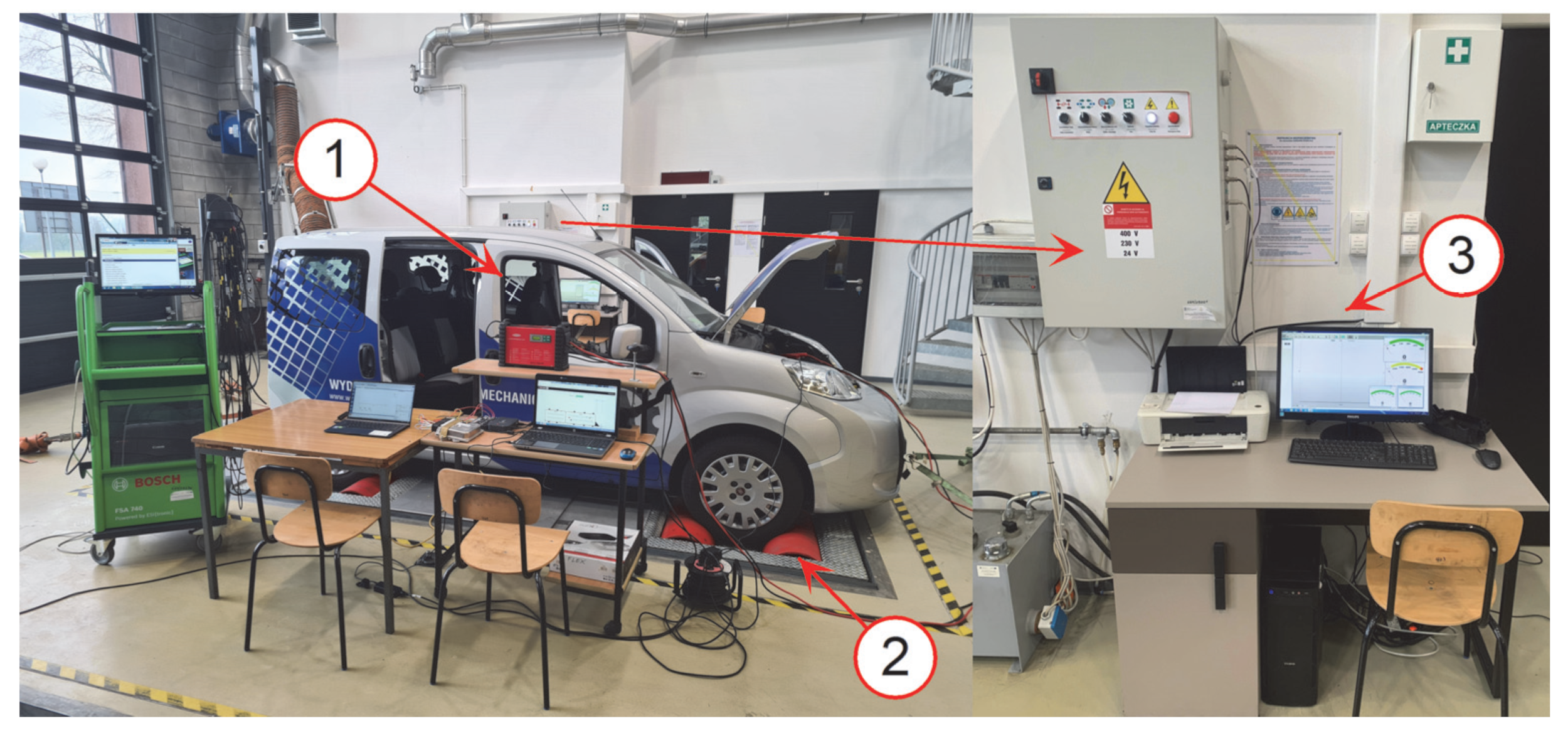
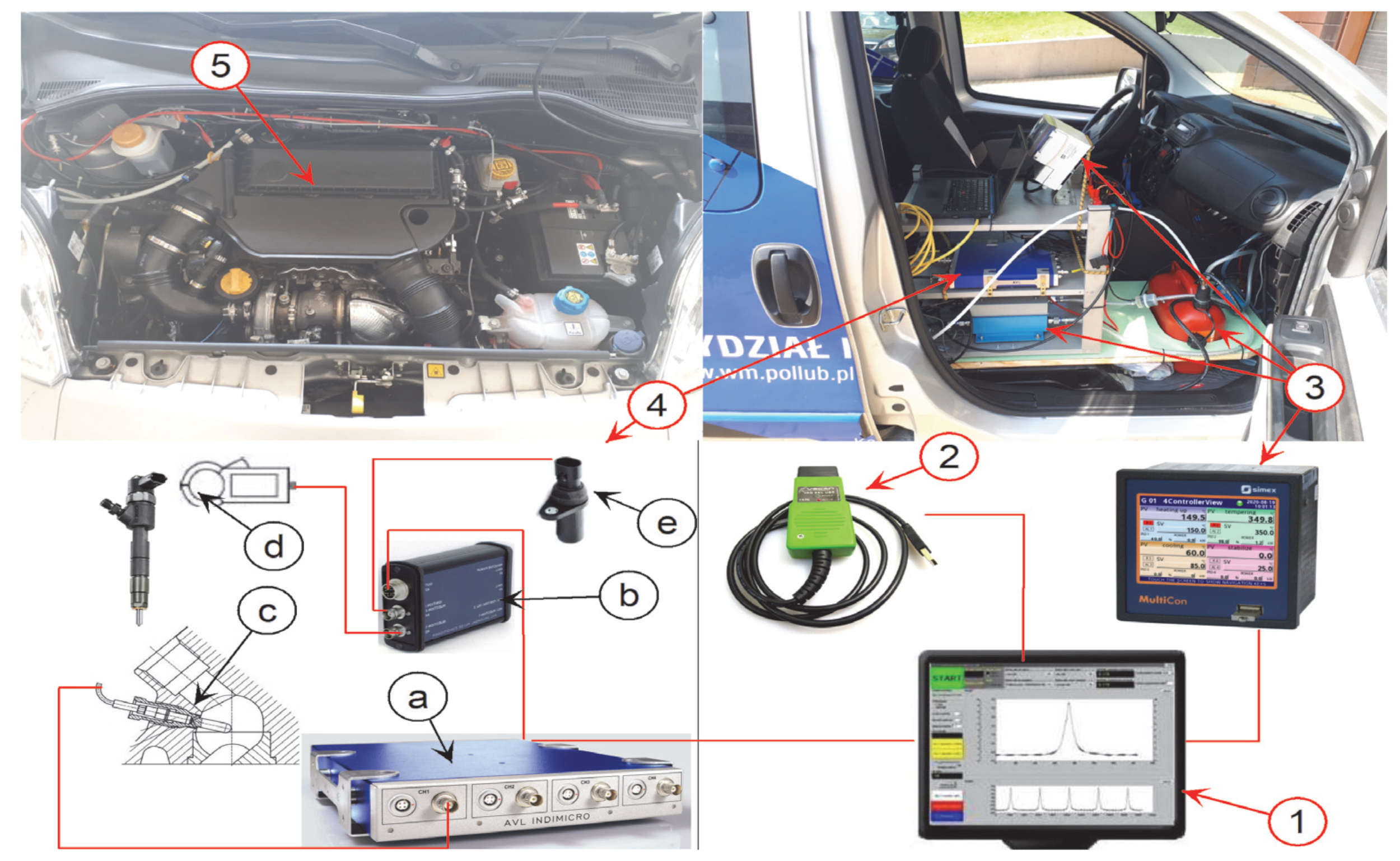
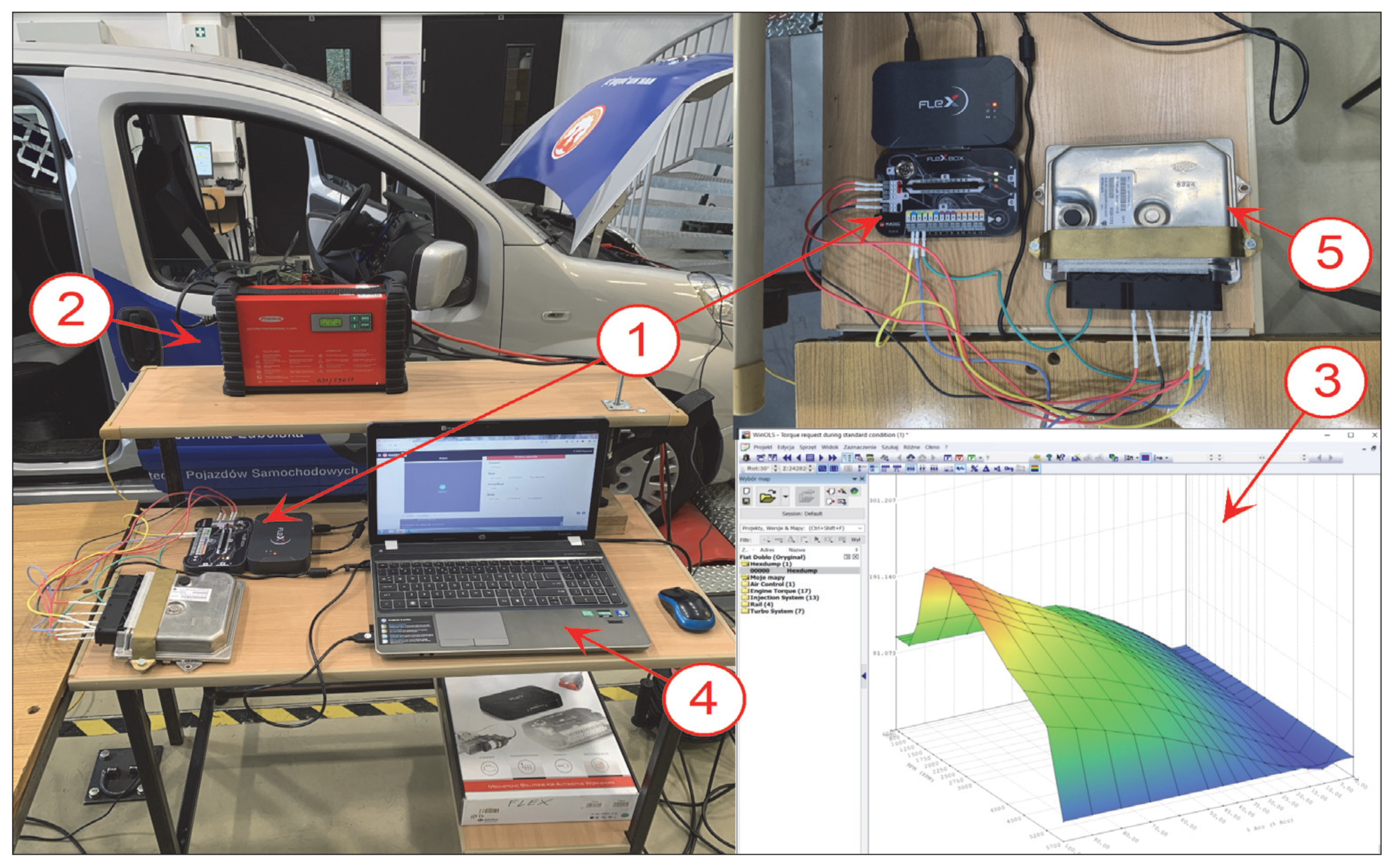

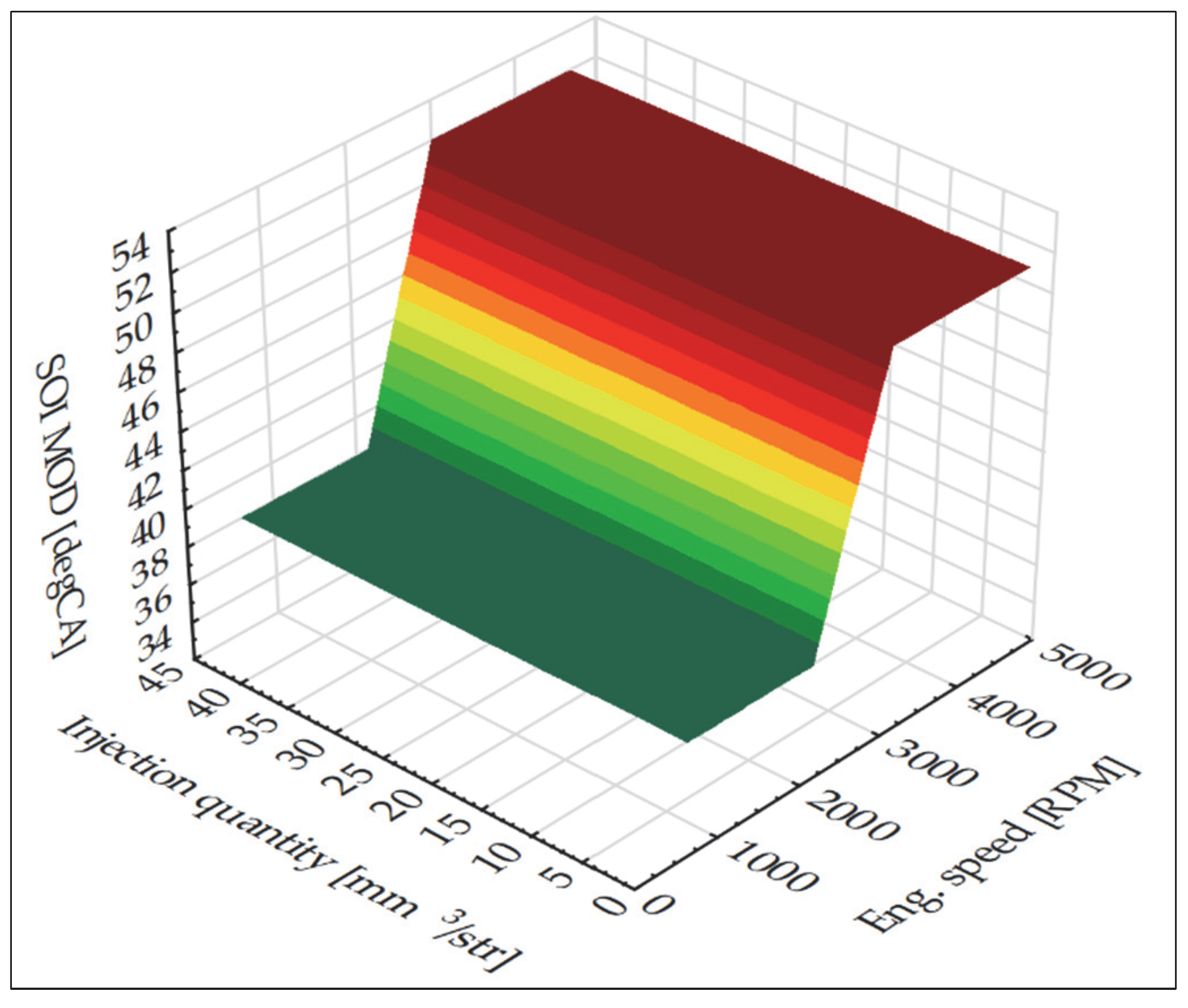
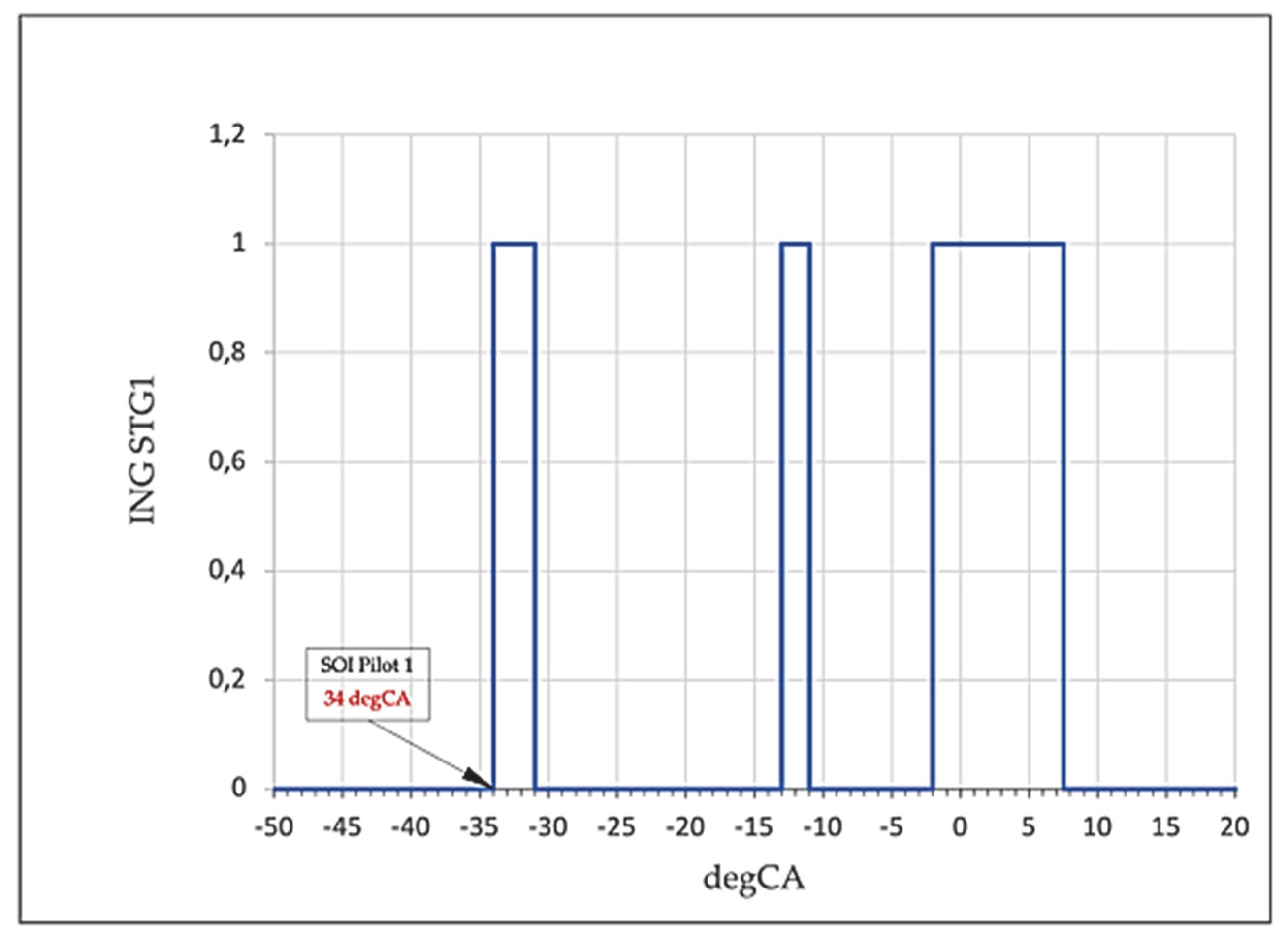
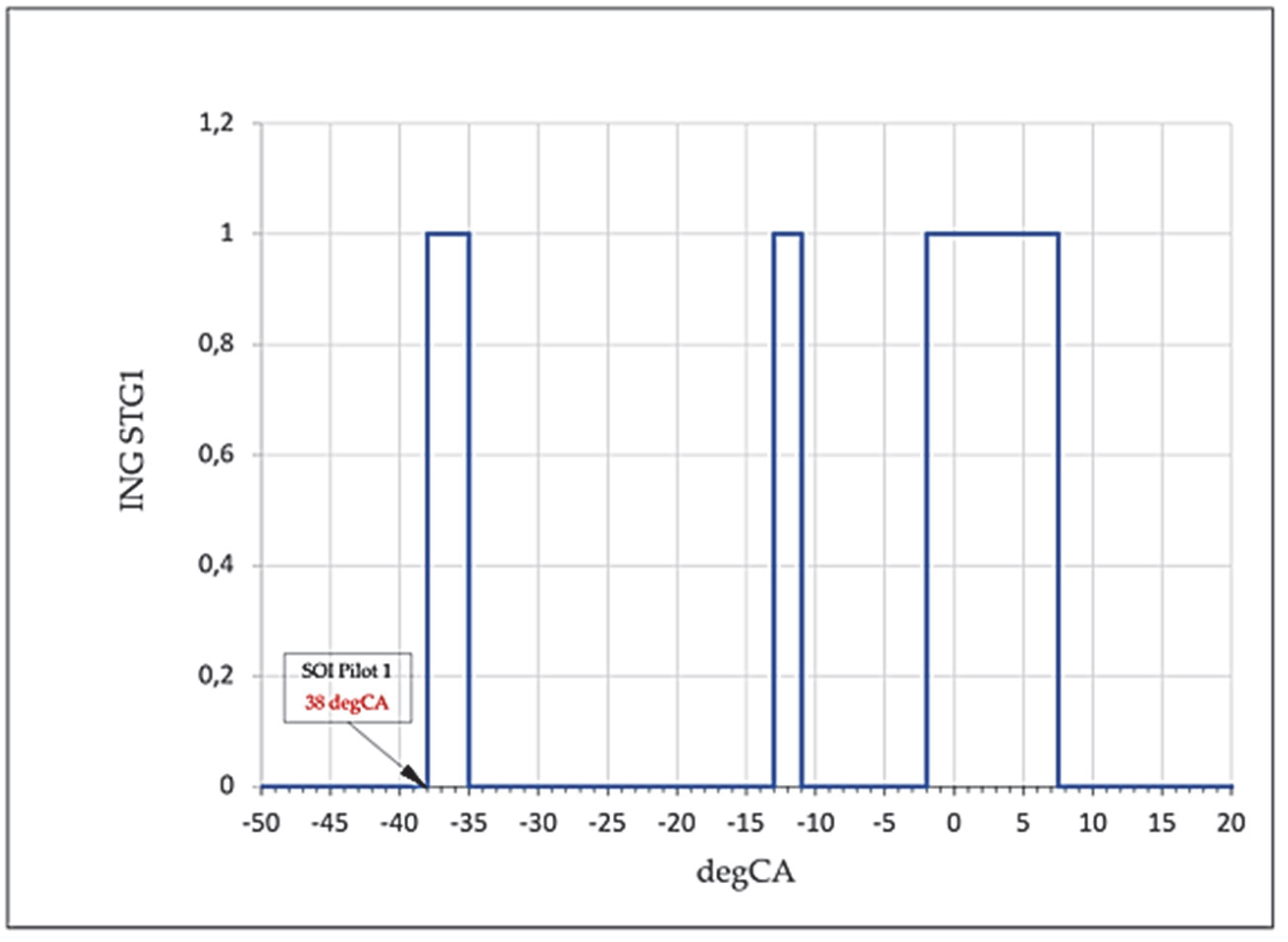

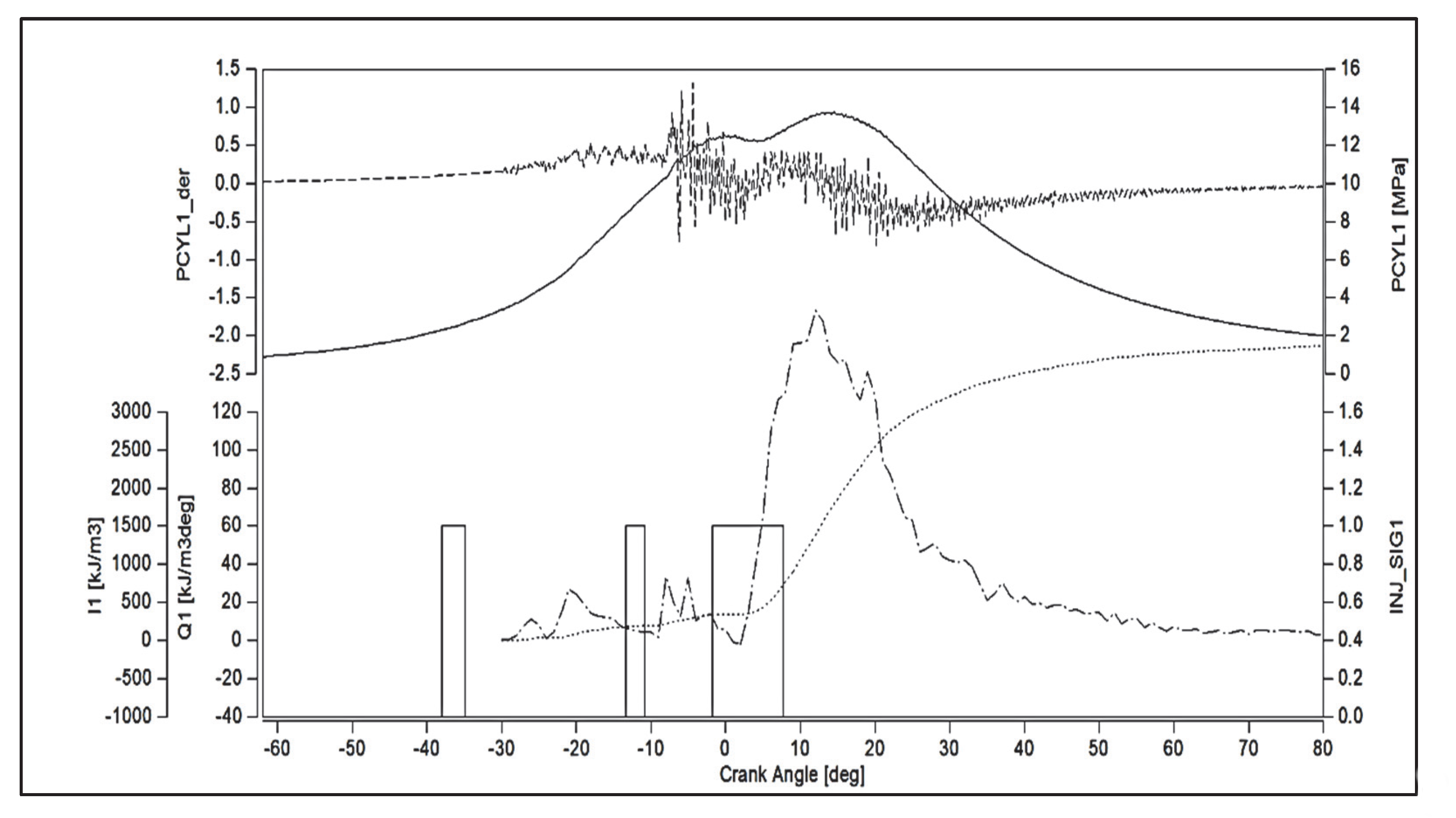
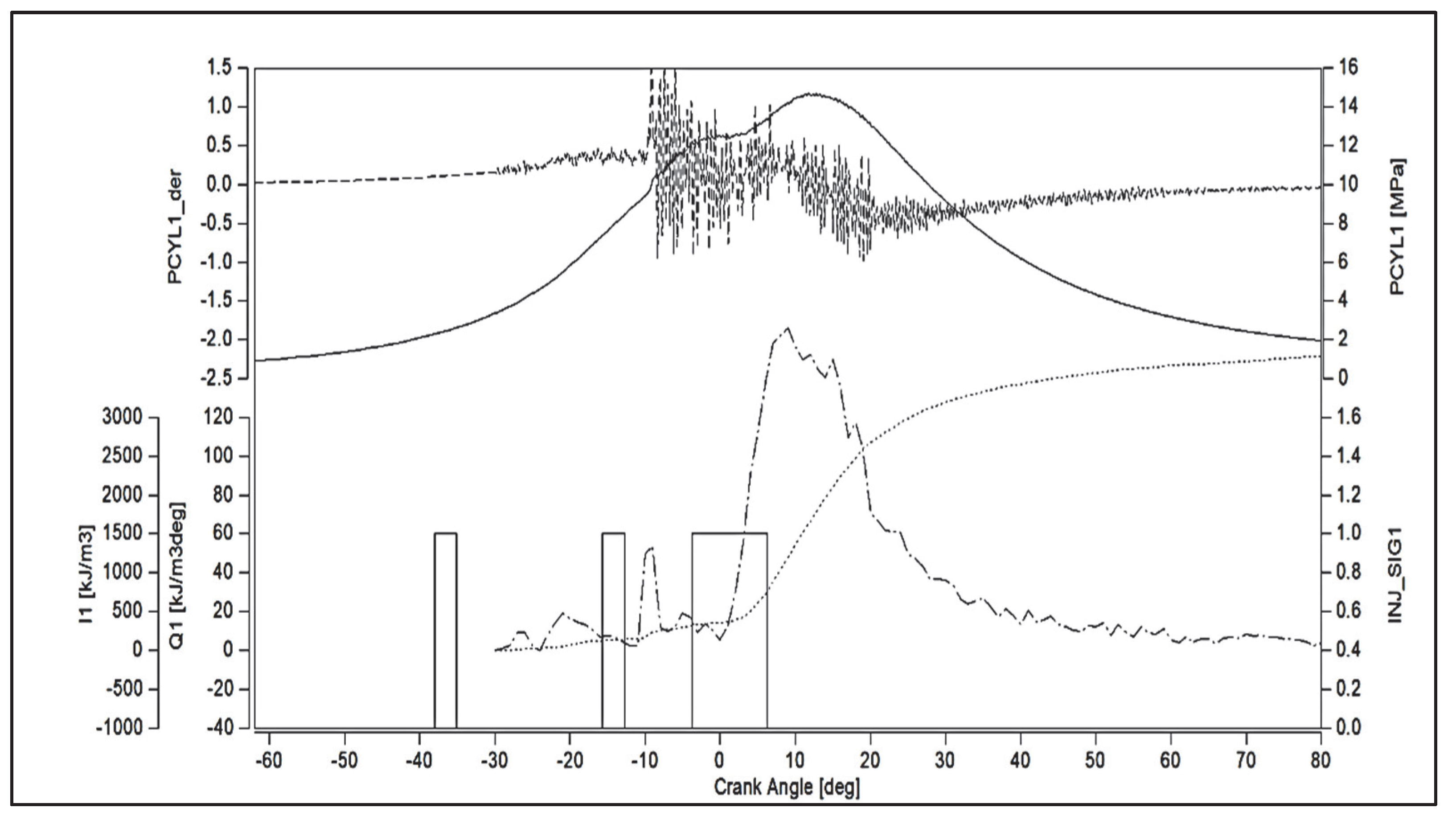
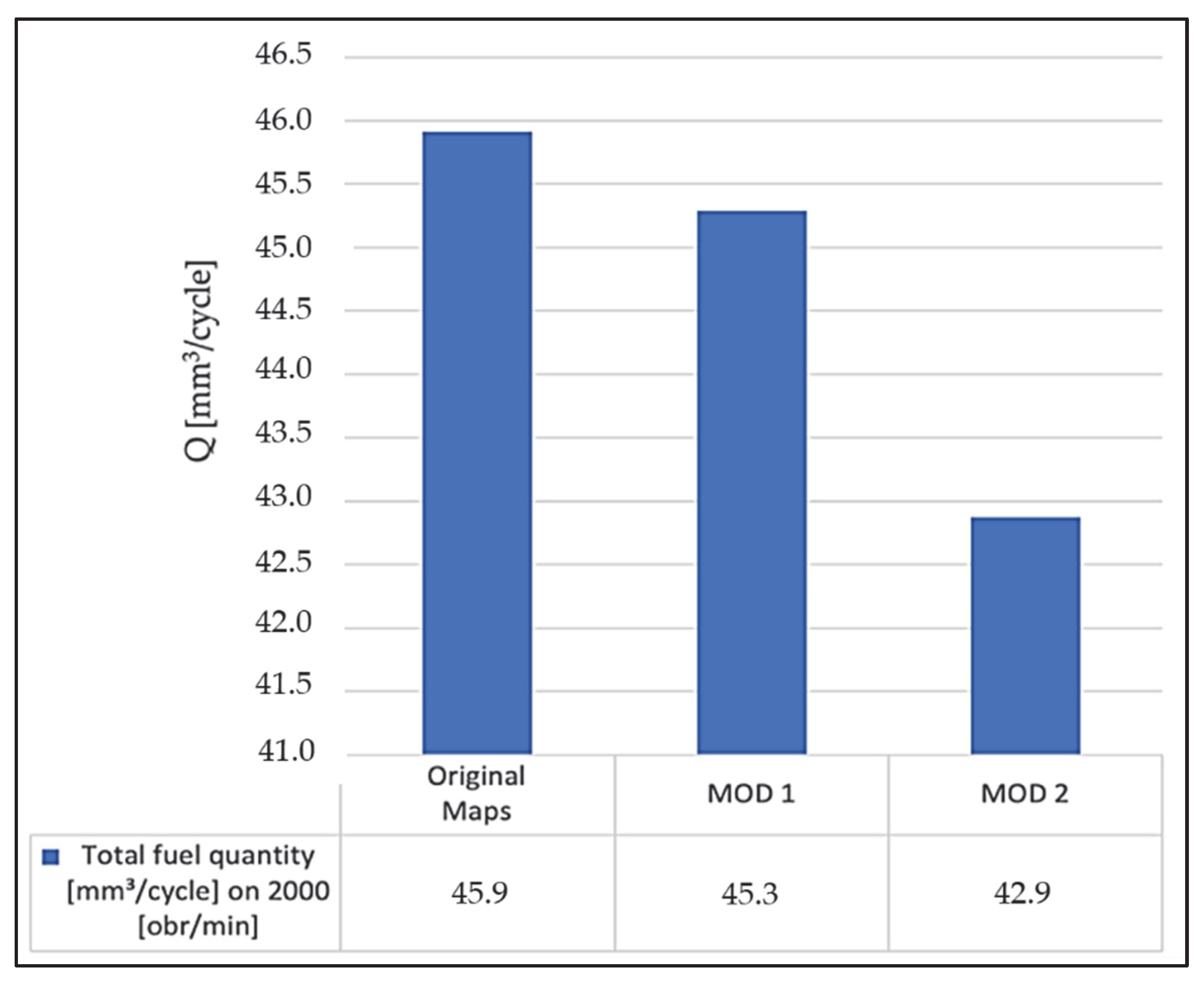
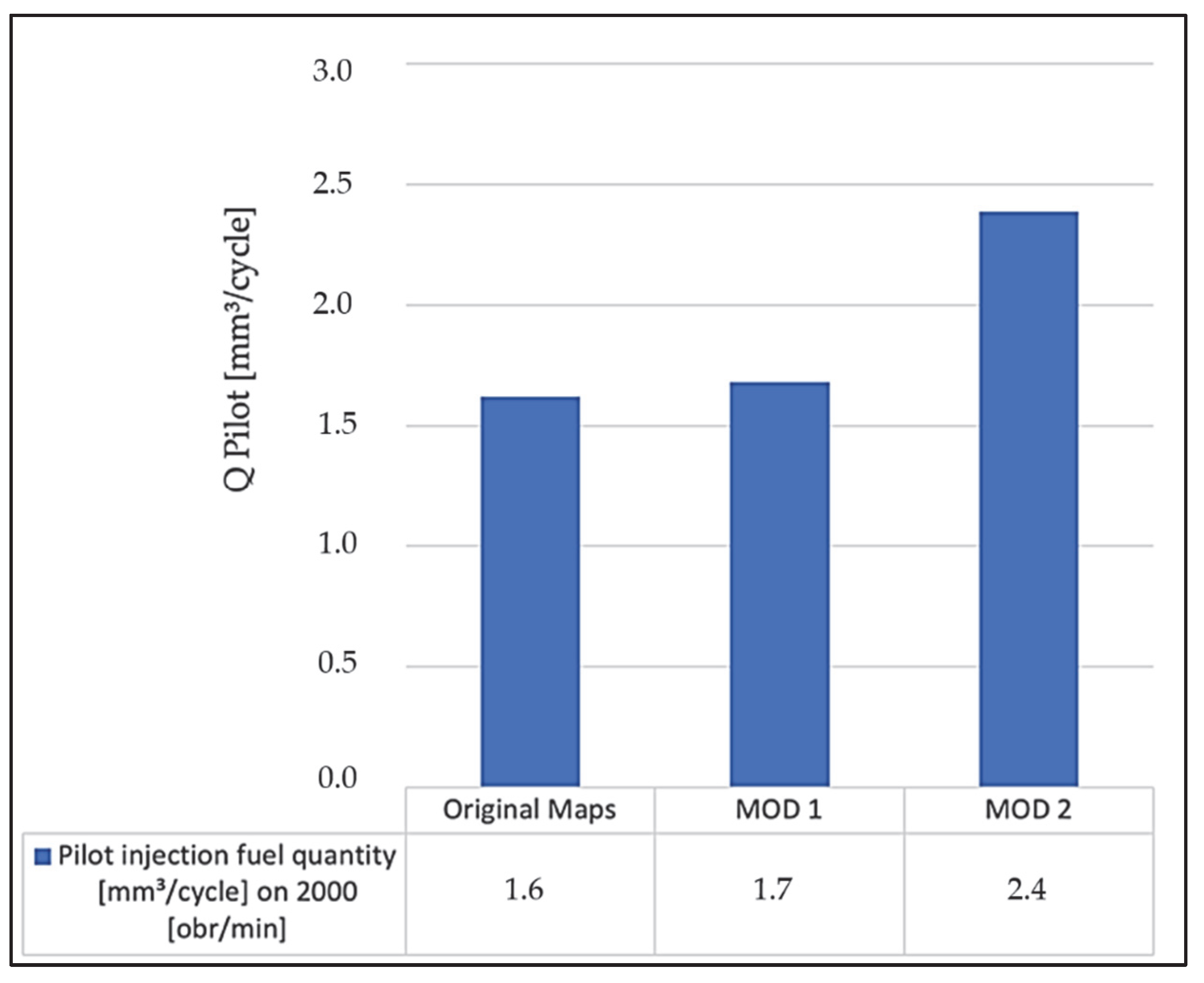
| Parameter | Characteristics |
|---|---|
| Name | Fiat Qubo |
| Production year | 2015 |
| Engine capacity | 1248 cm3 |
| Cylinder number and arrangement | 4, in line |
| Cylinder diameter | 69.6 mm |
| Piston stroke | 82 mm |
| Compression ratio | 16.8: 1 |
| Max power | 55 kW CEE/75 KM CEE |
| Max torque | 190 Nm CEE/kgm CEE |
| Idle speed | 850 ± 20 RPM |
| Rotational speed at maximum torque | 1500 RPM |
| Injection system/fuel supply | Common Rail/diesel |
| Exhaust gas cleaning systems | EGR, DPF |
| Parameter | Characteristics |
|---|---|
| Maximum axle load | 2500 kg |
| Maximum speed | 300 km/h |
| Maximum power on accelerated axle | 400 kW |
| Maximum power on continuously loaded axle | 300 kW |
| Tractive force | 7500 N |
| Measurement accuracy | +/−2% |
| Modification Number | Change Parameters |
|---|---|
| ORI | Original maps |
| MOD1 | (+)4 deg PREinj (+)2 deg MAINinj |
| MOD2 | (+)4 deg PREinj (+)2 deg MAINinj (+)1 mm3 PREinj |
| Modification Number | Parameters for 2000 [rpm] and 130 [Nm] | |||||
|---|---|---|---|---|---|---|
| SOI | SOC | τ | IMEP | PCYL1MAX | PCYL1_der | |
| [deg] | [deg] | [deg] | [MPa] | [MPa] | MPa/deg | |
| Original | −34 | −7.85 | 26.18 | 1.88 | 13.05 | 0.447 |
| MOD1 | −38 | −9.55 | 28.42 | 2.0 | 13.74 | 0.619 |
| MOD2 | −38 | −9.60 | 28.38 | 1.99 | 14.61 | 0.766 |
Publisher’s Note: MDPI stays neutral with regard to jurisdictional claims in published maps and institutional affiliations. |
© 2022 by the authors. Licensee MDPI, Basel, Switzerland. This article is an open access article distributed under the terms and conditions of the Creative Commons Attribution (CC BY) license (https://creativecommons.org/licenses/by/4.0/).
Share and Cite
Tatarynow, D.; Longwic, R.; Sander, P.; Zieliński, Ł.; Trojgo, M.; Lotko, W.; Lonkwic, P. Test Stand for a Motor Vehicle Powered by Different Fuels. Appl. Sci. 2022, 12, 10683. https://doi.org/10.3390/app122010683
Tatarynow D, Longwic R, Sander P, Zieliński Ł, Trojgo M, Lotko W, Lonkwic P. Test Stand for a Motor Vehicle Powered by Different Fuels. Applied Sciences. 2022; 12(20):10683. https://doi.org/10.3390/app122010683
Chicago/Turabian StyleTatarynow, Dawid, Rafał Longwic, Przemysław Sander, Łukasz Zieliński, Michał Trojgo, Wincenty Lotko, and Paweł Lonkwic. 2022. "Test Stand for a Motor Vehicle Powered by Different Fuels" Applied Sciences 12, no. 20: 10683. https://doi.org/10.3390/app122010683
APA StyleTatarynow, D., Longwic, R., Sander, P., Zieliński, Ł., Trojgo, M., Lotko, W., & Lonkwic, P. (2022). Test Stand for a Motor Vehicle Powered by Different Fuels. Applied Sciences, 12(20), 10683. https://doi.org/10.3390/app122010683







